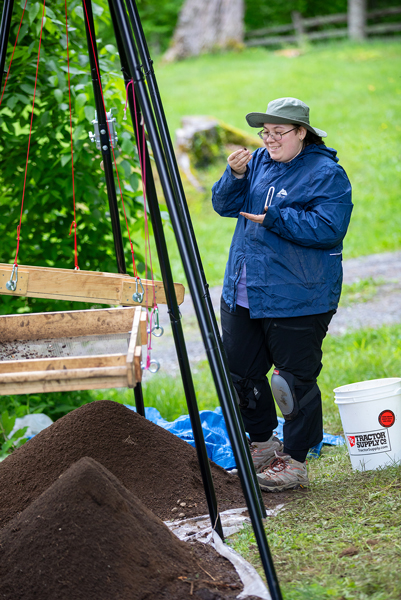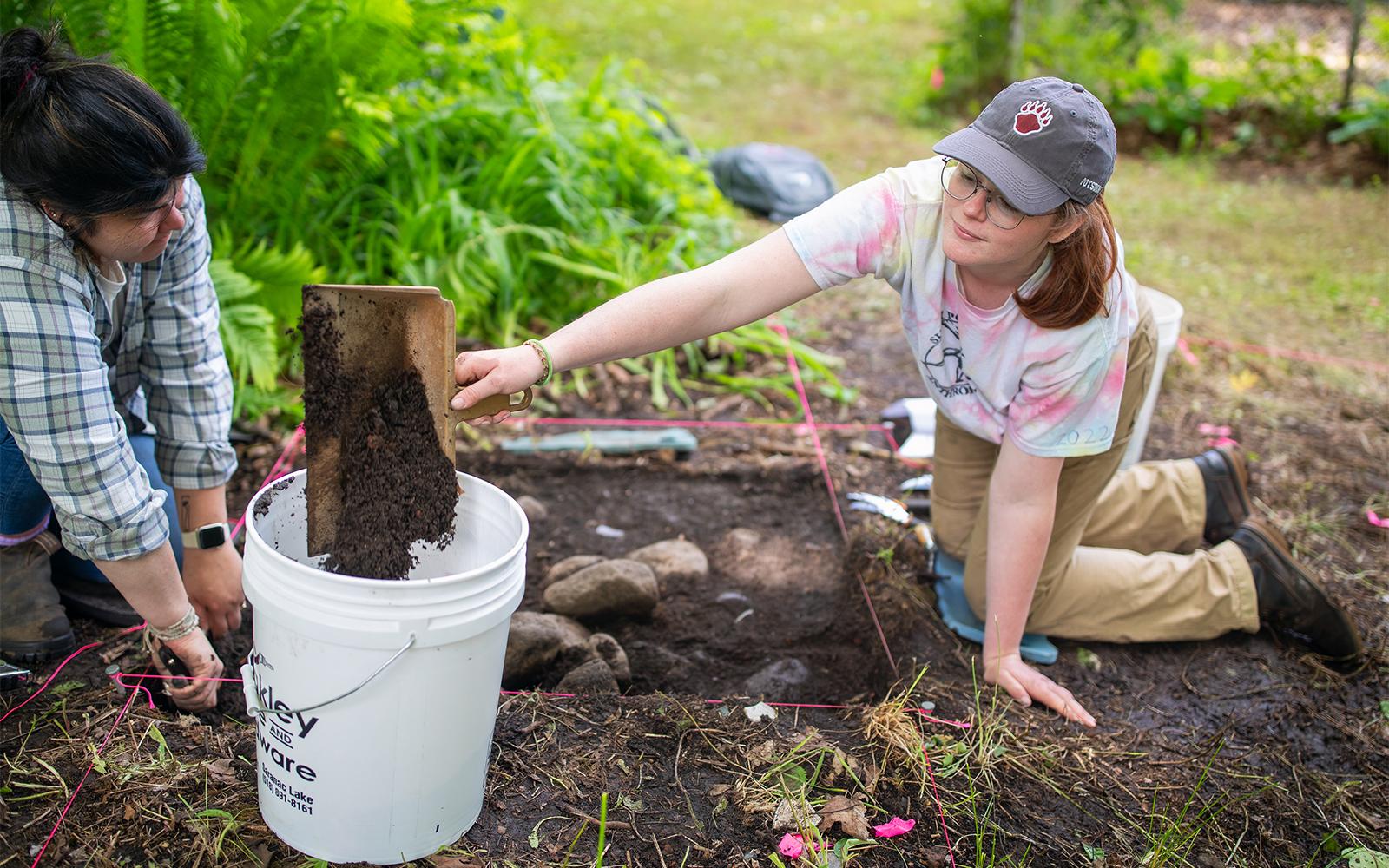Working in the woods behind a historic Adirondack farmstead, Kathryn Nelson ’26 uses a screen to separate artifacts from the soil. Ceramic, glass and metal rise to the surface with each shake of the wrist as she unveils clues from the 19th century.
“Excavating smaller units, using the sifters, and taking soil samples is something I've never done before, but learning how to do it properly has been a great experience."
Nelson is one of a dozen students who completed a month-long archaeology field school this summer in Lake Placid, N.Y., at the Uihlein Foundation’s Heaven Hill Farm, a 1,000-acre property with sweeping views of the High Peaks.
Led by Dr. Hadley Kruczek-Aaron, a professor in the Department of Anthropology, the field school provides archaeology students with an immersive hands-on experience to implement skills from the classroom in a real-world setting. “For decades, we have had a history of conducting fieldwork through the archaeological studies program. This is the eighth field school that I've led at SUNY Potsdam, and this year is a continuation of the Timbuctoo project that I’ve been working on since 2009,” she said.
Dr. Hadley Kruczek-Aaron works with students on Heaven Hill Farm.
 The project has allowed Kruczek-Aaron and her students to examine several sites around Lake Placid associated with Black farmers who settled in the region in the mid-1800s. Each archaeological dig that Kruczek-Aaron has led over the past 15 years has been tied back in some way to a pinnacle moment in 1846 when abolitionist Gerrit Smith gave 120,000 acres of land to 3,000 Black New Yorkers to combat a racist law requiring them to own $250 worth of land in order to vote.
The project has allowed Kruczek-Aaron and her students to examine several sites around Lake Placid associated with Black farmers who settled in the region in the mid-1800s. Each archaeological dig that Kruczek-Aaron has led over the past 15 years has been tied back in some way to a pinnacle moment in 1846 when abolitionist Gerrit Smith gave 120,000 acres of land to 3,000 Black New Yorkers to combat a racist law requiring them to own $250 worth of land in order to vote.
The Timbuctoo experiment, as it was known, created opportunities for Black families to prosper during a dark time in American history when 4 million people were still enslaved in the South. Men like Lyman Epps were able to establish a farm in Northern New York, maintain voting rights, and embrace freedom in the years leading up, during, and after the Civil War—a historical period that is now providing a unique framework for SUNY Potsdam students to conduct archaeological fieldwork in the heart of the Adirondacks.
“Through our digs in 2009, 2011 and 2013, we were trying to find the homestead of Lyman Epps, one of the grantees who was here for the longest. We weren’t successful in finding enough mid-19th-century objects for me to feel confident that we had hit their homestead, and so since then, I've been rethinking the strategy. In 2017, we went to the John Brown farm. Doing that project reframed my thinking of the broader community that partnered with the grantees, and with that in mind, telling the broader community story of Timbuctoo, we ended up here at Heaven Hill Farm in 2022 in a similar vein,” Kruczek-Aaron said.
This summer, they returned to Heaven Hill Farm, the historic former home of Anna Newman, a wealthy single white woman from Philadelphia who moved to the Adirondacks in 1876. Newman had hired Epps to assist her on the farm and established herself as one of the area's leading employers for farm laborers. “As a site of employment for the Epps family, it gives us a window into their survival strategies in the Adirondacks. They had to work for other people to be able to make a living. He was working here and driving the team of oxen on this property. Digging at Anna Newman’s house illuminates that part of the story. We're documenting some of those connections and walking in the footsteps of the Epps family by being here,” Kruczek-Aaron said.
With all this history in the back of their minds, SUNY Potsdam students Sydney O’Melia ’24, Sebastian Herrera ’25 and Leia’lani Dibble ’26 work together to loosen the dirt in their excavation unit with trowels and other tools. One stratum at a time, they dig deeper into the earth, collecting buckets full of soil to shake through a screen and reveal artifacts belonging to Newman and the people who farmed the land with her.
“We found some really awesome things as we were excavating our units. This is my first field school. We’ve done some compass work and grid mapping, and we also used a total station. It’s been really nice getting to learn more about the techniques," O’Melia said.
“Archaeology takes material culture and we’re able to shape a history that’s not written, and I think just understanding and learning more about cultures in a wholistic sense, rather than through one perspective, is what really draws me to it."

As they found pieces of ceramic dishes used by Newman, they drew connections between the artifacts and Newman’s lifestyle on the farm. “We're continuing to try and document what life was like for the past 200 years of this property's history, and we do that by looking for objects that speak to everyday life like food remains, shell, bone, ceramics and glass,” said Kruczek-Aaron. “One of the things that we seem to be seeing with Newman is that she took a more frugal approach to consumption, based on the results so far. She's not spending a lot on her ceramics and that makes me think that she's spending more on philanthropy, as an employer, and on the improvements to the farm.”
One of those improvements, a wooden water pipe system that shuttled fresh spring water directly into the house, was discovered in a small patch of earth outside Newman’s kitchen door. Students dug a small test pit and then cut out a larger excavation unit, as they tried to expose more of the pipe system through a process called ground truthing.
“That water pipe system was not common in private homes, it was something that you might see at the municipal level of a city, but she's spending her money to make improvements on her farm, as opposed to getting fancy porcelain dishes, so that’s interesting,” Kruczek-Aaron said.
As the students wrapped up four weeks of fieldwork and bagged hundreds of artifacts for future lab work, they are heading back to SUNY Potsdam this fall with an in-depth understanding of hands-on archaeological field methods. In the spring of 2025, Nelson and her classmates will be meticulously sorting through the artifacts in Kruczek-Aaron’s Archaeological Lab Techniques class—learning additional skills including cleaning, cataloging, and conducting vessel reconstruction.
“This field school has been such a wonderful opportunity and I've had so much fun being here,” Nelson said. “I have learned so much more than a textbook could teach me.”
Article and photos by Jason Hunter
